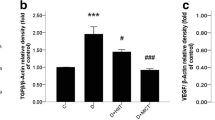Summary
In order to investigate the promoting effect of low-intensity treadmill exercise on rat dorsal wound healing and the mechanism, 20 Sprague-Dawley rats were randomly divided into two groups: exercise group (Ex) and non-exercise group (non-ex). The rats in Ex group were given treadmill exercise for one month, and those in non-ex group raised on the same conditions without treadmill exercise. Both groups received dorsal wound operation with free access to food and water. By two-week continuous observation and recording of the wound area, the healing rate was analyzed. The blood sample was collected at day 14 post-operation via cardiac puncture for determination of the number of endothelial progenitor cells (EPCs) by flow cytometry, and the concentrations of relevant cytokines such as basic fibroblast growth factor (bFGF), endothelial nitric oxide synthase (eNOS) and vascular endothelial growth factor (VEGF) were measured by ELISA. The skin tissue around the wound was dissected to observe the vascular density under the microscope after HE staining, to detect the mRNA level of VEGFR2 and angiopoietin-1 (Ang-1) receptor using RT-qPCR, and protein expression of a-smooth muscle actin (αSMA) and type III collagen (ColIII) using Western blotting. It was found that the wound area in Ex group was smaller at the same time point than in non-ex group. The number of circulating EPCs was greater and the concentrations of vasoactive factors such as VEGF, eNOS and bFGF were higher in Ex group than in non-ex group. HE staining displayed a higher vessel density in Ex group than in non-ex group. Moreover, the mRNA expression of VEGFR2 and Ang-1 detected in the wound tissue in Ex group was higher than in non-ex group. Meanwhile, the protein expression of αSMA and ColIII was more abundant in Ex group than in non-ex group. Conclusively, the above results demonstrate Ex rats had a higher wound healing rate, suggesting low-intensity treadmill exercise accelerates wound healing. The present work may provide some hint for future study of treating refractory wound.
Similar content being viewed by others
References
Caiado F, Carvalho T, Silva F, et al. The role of fibrin E on the modulation of endothelial progenitors adhesion, differentiation and angiogenic growth factor production and the promotion of wound healing. Biomaterials, 2011,32(29):7096–7105
Suh W, Kim KL, Kim JM, et al. Transplantation of endothelial progenitor cells accelerates dermal wound healing with increased recruitment of monocytes/macrophages and neovascularization. Stem Cells, 2005,23(10): 1571–1578
Woo KY, Botros M, Kuhnke J, et al. Best practices for the management of foot ulcers in people with diabetes. Adv Skin Wound Care, 2013,26(11):512–524
Forsberg J, Potter B, Cierny GR, et al. Diagnosis and management of chronic infection. J Am Acad Orthop Surg, 2011,19(Supp1):1–8
Pence BD, Dipietro LA, Woods JA. Exercise speeds cutaneous wound healing in high-fat diet-induced obese mice. Med Sci Sports Exerc, 2012,44(10):1846–1854
Keylock KT, Vieira VJ, Wallig MA, et al. Exercise accelerates cutaneous wound healing and decreases wound inflammation in aged mice. Am J Physiol Regul Integr Comp Physiol, 2007,294(1):R179–R184
Guo S, Yu L, Cheng Y, et al. PDGFRbeta triggered by bFGF promotes the proliferation and migration of endothelial progenitor cells via p-ERK signalling. Cell Biol Int, 2012,36(10):945–950
Grochot-Przeczek A, Dulak J, Jozkowicz A. Therapeutic angiogenesis for revascularization in peripheral artery disease. Gene, 2013,525(2):220–228
Steiner S, Niessner A, Ziegler S, et al. Endurance training increases the number of endothelial progenitor cells in patients with cardiovascular risk and coronary artery disease. Atherosclerosis, 2005,181(2):305–310
Rehman J, Li J, Parvathaneni L, et al. Exercise acutely increases circulating endothelial progenitor cells and monocyte-/macrophage-derived angiogenic cells. J Am Coll Cardiol, 2004,43(12):2314–2318
Tokuda S, Kai M, Kawahara S, et al. Changes in carbonic anhydrase activity in rat skeletal muscles due to aerobic treadmill exercise. J Sports Med Phys Fitness, 1987,27(3): 380–384
Bai H, Forrester JV, Zhao M. DC electric stimulation upregulates angiogenic factors in endothelial cells through activation of VEGF receptors. Cytokine, 2011,55(1):110–115
Shahrara S, Volin MV, Connors MA, et al. Differential expression of the angiogenic Tie receptor family in arthritic and normal synovial tissue. Arthritis Res, 2002,4(3):201–208
Wilgus TA, Matthies AM, Radek KA, et al. Novel function for vascular endothelial growth factor receptor-1 on epidermal keratinocytes. Am J Pathol, 2005,167(5): 1257–1266
Feng Y, Yang S, Xiao B, et al. Decreased in the number and function of circulation endothelial progenitor cells in patients with avascular necrosis of the femoral head. Bone, 2010,46(1):32–40
Gui C, Li SK, Nong QL, et al. Changes of serum angiogenic factors concentrations in patients with diabetes and unstable angina pectoris. Cardiovasc Diabetol, 2013,12: 34
Wang XH, Chen SF, Jin HM, et al. Differential analyses of angiogenesis and expression of growth factors in micro-and macrovascular endothelial cells of type 2 diabetic rats. Life Sci, 2009,84(7–8):240–249
Losi P, Briganti E, Errico C, et al. Fibrin-based scaffold incorporating VEGF-and bFGF-loaded nanoparticles stimulates wound healing in diabetic mice. Acta Biomater, 2013,9(8):7814–7821
Tang X, Yang Y, Yuan H, et al. Novel transcriptional regulation of VEGF in inflammatory processes. J Cell Mol Med, 2013,17(3):386–397
Van Slyke P, Alami J, Martin D, et al. Acceleration of diabetic wound healing by an angiopoietin peptide mimetic. Tissue Eng Part A, 2009,15(6):1269–1280
Kao HK, Chen B, Murphy GF, et al. Peripheral blood fibrocytes: enhancement of wound healing by cell proliferation, re-epithelialization, contraction, and angiogenesis. Ann Surg, 2011,254(6):1066–1074
Choi W, Kawanabe H, Sawa Y, et al. Effects of bFGF on suppression of collagen type I accumulation and scar tissue formation during wound healing after mucoperiosteal denudation of rat palate. Acta Odontol Scand, 2008,66(1): 31–37
Author information
Authors and Affiliations
Corresponding authors
Additional information
This study was supported by the National Natural Science Foundation of China (No. 81141077 and No. 81271968).
Rights and permissions
About this article
Cite this article
Zhou, W., Liu, Gh., Yang, Sh. et al. Low-intensity treadmill exercise promotes rat dorsal wound healing. J. Huazhong Univ. Sci. Technol. [Med. Sci.] 36, 121–126 (2016). https://doi.org/10.1007/s11596-016-1553-3
Received:
Revised:
Published:
Issue Date:
DOI: https://doi.org/10.1007/s11596-016-1553-3




